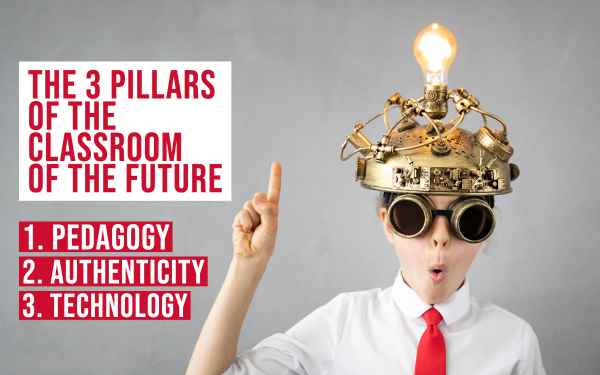Build the classroom of the future with these 3 key pillars
 Lucie Renard —
Lucie Renard —
For years now, classrooms are changing for the better. Every classroom should enable students to learn; that’s purpose doesn’t change. But how your students learn is evolving with modern time.
I always rattle on about the modern classroom, the digital classroom, the future classroom. However, it’s pretty much just an empty classroom if you don’t understand what it is. That’s why, in this post, I asked two other experts in the education field, Alex More and Marc Hermans, how they think a modern classroom should look like. They both have built one, so they know what they’re talking about.
What does the future classroom look like?
Let’s turn things around, and start with the conclusion of this post. While doing both interviews, I was convinced about the exclusive role of technology in a future classroom. I was wrong … (yes, it happens. 🤷♀️)
Alex More’s future classroom
 Alex
More
- Lead Teacher of Innovation in Teaching and Learning at Shaftesbury school -
launched a future
classroom,
based on his research and thinking around education. His future classroom
model is based on flipped
learning,
so students can access the learning material ahead of each lesson. On top of that, he’s working with cutting edge
technologies.
Alex
More
- Lead Teacher of Innovation in Teaching and Learning at Shaftesbury school -
launched a future
classroom,
based on his research and thinking around education. His future classroom
model is based on flipped
learning,
so students can access the learning material ahead of each lesson. On top of that, he’s working with cutting edge
technologies.
“The future classroom is the ideal combination between the latest technology and the best pedagogy.” - Alex More
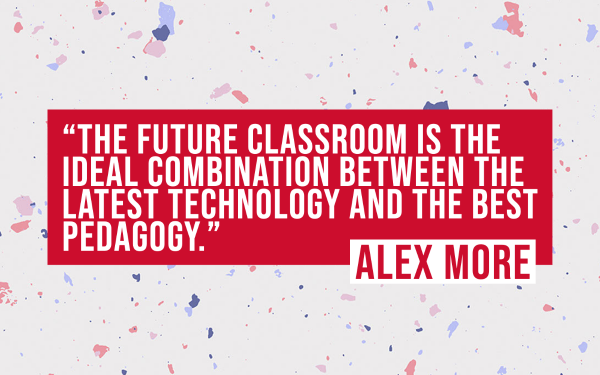
Marc Hermans’ future classroom
 Marc
Hermans is the head of the
education department at PXL University College in Belgium. Here, students study
to become teachers.
Marc
Hermans is the head of the
education department at PXL University College in Belgium. Here, students study
to become teachers.
Teaching future teachers comes with many challenges; they notice that 1 out of 2 new teachers drop out of teaching within the first 5 years. Starting from this problem, the PXL University College had to find a solution. That’s why they created this “future classroom”.
“The future classroom must be authentic, didactical, and innovative. Classrooms of the future are “experience” classrooms.” - Marc Hermans
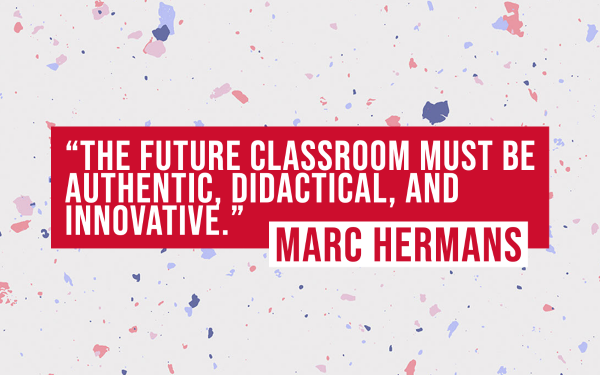
Surprise, surprise! Both Alex More and Marc Hermans have pretty much the same vision when it comes to creating a classroom of the future. That’s how I determined these 3 important pillars in the future classroom: pedagogy, authenticity, and technology.
1. Pedagogy
Alex More experimented in his future classroom with two known educational models.
Model A
The first one is the 27 Minute ALT Model of John Hattie. Basically, he splits the learning time in two. Two times 27 minutes, as 27 minutes is the time students are actively, successfully, and productively engaged in learning relevant academic content.
The first 27 minutes go to flipped learning and direct instruction. Here, he teaches his students new lesson content.
The last 27 minutes go to testing what they’ve learned in the first 27 minutes. The purpose is to embed knowledge into their long term memory. Students create, engage, and embed content in different ways. The lesson ends with an exit ticket.
Model B
This learning model focuses on collaborative working teams. It places the teacher in the “mentor” role, making them a “guide on the side” instead of a “preacher teacher”. Alex uses the SOLO taxonomy (Briggs & Collins) to set differentiated lesson objectives. Students set their own starting point. Students will experiment with ideas, they’ll fail, they’ll recover, find the solution and grow. As your students are each on their own path (in Teams), lessons can get messy. That’s why Alex brought in 3 golden rules:
Have a clear objective for the lesson. Alex shares a flipped learning tasks, so students know what the focus of the lesson will be before they arrive.
Design learning teams. Rearrange your classroom and allocate clear roles. You know your students, so you can choose whether to create teams with 3, 4, or 5 students. Alex has learned that teams of 4 have experienced more successes.
Separate the lessons into two clear learning episodes. This is where model A peaks around the corner. Alex recommends the first 27 minutes as discovery time and the last 27 minutes serve as presentation time.
As Alex’s future classroom has students that play different parts within their teams, he introduced team roles that align with the business world and job market. There’s a team leader, assistant team leader, scribe, speaker, and research analyst.
Another interesting part that aligns with his collaborative working teams idea is the way he designed his classroom space. All the way around, students have whiteboards at their disposal. So, not just one whiteboard only the teacher uses, but 360° writing surface.
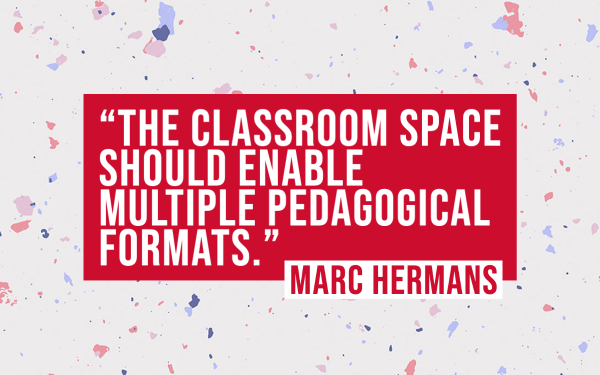
Flexibility
This combination of the 360° writing surface and use of technology in Alex’s classroom aligns with Marc’s ideas as well.
“A classroom space should enable different pedagogical formats. The classroom of the future is a flexible classroom “ - Marc Hermans
Your future classroom should support all kinds of teaching methods such as speeching, encourage discussions and debates, giving demos, showing documentaries, digital assignments, corner work, learning in motion, group work, individual work, and so on. This means that you should be able to change the classroom set-up whenever you want.
2. Authenticity
Students need to succeed in real life. We have to make sure they don’t drop out of school or drop out of their future jobs. To do this, we have to give students a learning experience that equals their future experience in real life.
Marc Hermans and his team researched lots of different Kindergartens and primary school classrooms to create the ultimate classroom for his teacher students. They wanted to create a classroom that has all the possible setups and that matches the reality. Classrooms setups differ from school to school. From a traditional classroom with just a chalkboard to a high tech classroom, all the students should be able to teach in both setups. This prevents students from disconnecting between what they were thought, and how it really is.
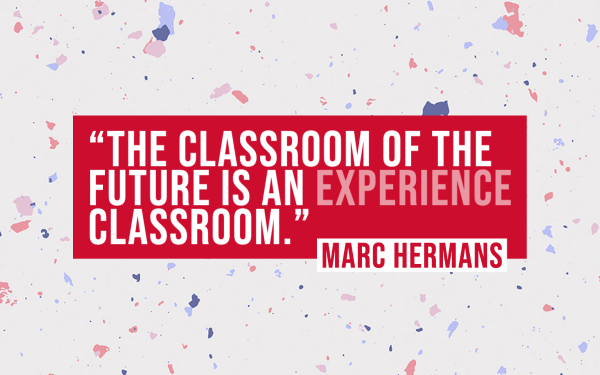
There are a few other ways to bring this authenticity to your lessons or classroom.
Dual learning: Dual learning suggests that students are combining learning and working. This means that students are practicing a real profession a few days a week. The PXL University College Education department switched from long internships at the end of the studies to dual learning at the beginning of their studies. Teacher students are confronted with the reality from day one and get monitored and coached much more intensively. This is also a way to close the reality gap between teacher students and real teachers.
Collaborative working teams, or Alex’s model B: This pedagogical model is designed to let students go through learning on their own terms. Just like in the job market, students need to be able to make decisions, experiment with ideas, finish tasks and learn on their own without someone else telling them what to do. It’s also called self-regulated learning.
Partnerships: Partner with private companies. For each lesson your students learn, private companies have projects up and running. Let your students apply for those projects, let them find the solutions while applying the lesson theory. You can also set up partnerships with educational centers that have modern technologies and more possibilities in their field of expertise. Let your students experiment with those new concepts. A good example is Belgium’s T2-campus. They have a program called “TECHville”. In this experience center, students learn to build a smart and sustainable city. They learn about AI, energy, coding, and much more.
Virtual reality: Teach students with their heads in the right position: align their learning with the real world. If you can’t get them to the real world, you can bring the real world to them by using virtual reality and augmented reality.
Co-teaching and teacher feedback: The student-teachers don’t teach their fellow students, but real toddlers and primary school students get a lesson from the student-teachers. Besides the main classroom, there’s a little space for other students and teachers, so they can watch the class from a distance. As everything is recorded in this future classroom, other students and teachers can follow the lesson on the side and give feedback on how their fellow student teaches. Learning by observation won’t change the behavior of the children here.
3. Technology
“The biggest mistake is thinking that technology can stand on its own.” - Alex More
Don’t choose technology just because it’s technology.
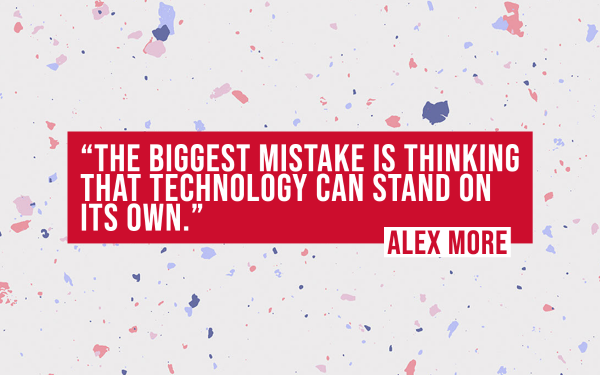
Both Alex and Marc had some important key-considerations when choosing the right technology for your future classroom. Here they are:
Space: can the technology be used in the classroom space? Look for the perfect space in your school. Not just any random classroom, but a wide space with lots of different set-up possibilities. Both Alex and Marc did this. Design a classroom in which everything works. Both technology as pedagogical models and different didactics.
Beware of the catch: don’t include technology that creates a false experience for the student, just because it’s fun to use.
Usability: every teacher should be able to use the technology in your classroom. Even the ones that aren’t tech-savvy.
Pro tip: Take a look at this blog post about important key considerations when choosing educational technology.
Here’s a list of technology that is significant for the classroom of the future. The technology I mention next is chosen carefully and based on the key considerations above.
A smart projector: Alex has a Smart Epson projector in his classroom. This projector has no blindspots so every student in the classroom space should be able to see the projected lesson content. As the projector makes it possible to turn dry-erase whiteboard and plain walls into interactive workspaces, you don’t need a fancy touch screen or digital board. The projector is interactive and reacts to 6 different students touching the screen. This makes it the perfect tool for collaboration as well.
The Learnometer: This little box measures whether the classroom has the ideal learning environment. It tracks 7 variables in the classroom, like CO2 levels, humidity, temperature, fine dust particles, chemicals, ambient light, and ambient noise.
Immersive Software apps: Alex installed the Mozaik 3D app as it works amazing with the smart projector and has 3D scenes for courses like history, geography, biology, and other science courses. Invest in apps and software that go for many classes as this classroom should be used in all kinds of subjects.
Virtual reality: When you have the budget, this is a good way to bring “real-life” to your classroom. Virtual reality can play a huge role when it comes to keeping learning real and authentic. There are lots of different educational VR apps that will enhance learning.
1 on 1 devices: You definitely don’t have to use the devices all the time. But giving every student its own device does broaden the horizon. Especially in times of Covid-19 and remote teaching. Why? Every student participates. They don’t just have to answer a question when you point them out. Now, they all have a way to answer the question and participate in your lesson all the time. Students will be more engaged and you get a clearer view of their learning process and progress. You can use, for example, BookWidgets to create digital assignments and fun learning games, monitor students live when they’re on an activity, and return work to the students with comprehensive and personal feedback.
Streaming system: Marc’s mockup future classroom has cameras that record every single corner in the classroom. This makes it possible for the student-teachers to rewatch their lessons and for other students to learn from each other. You can also use the cameras as a streaming system. If you have some absent students, they can still follow your lessons from a distance. This makes it possible to both teach in the classroom as online. It’s a hybrid classroom setup.
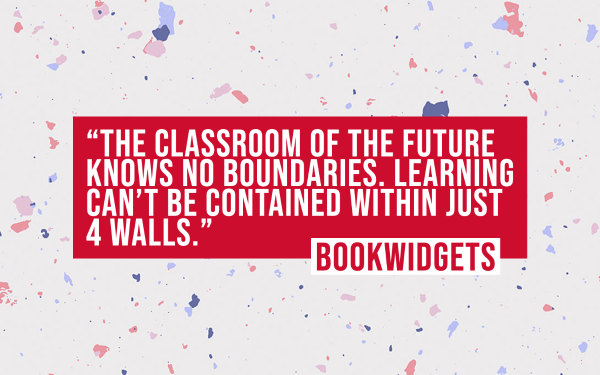
Wrap up
One thing is certain: the classroom of the future knows no boundaries. Learning can’t be contained within just 4 walls. So tell me, is your classroom future-proof?
Take the first step and follow our teacher blog. Learn all about integrating technology in your classroom and lessons to enhance your students’ learning.
